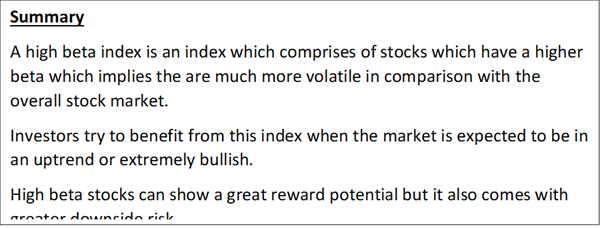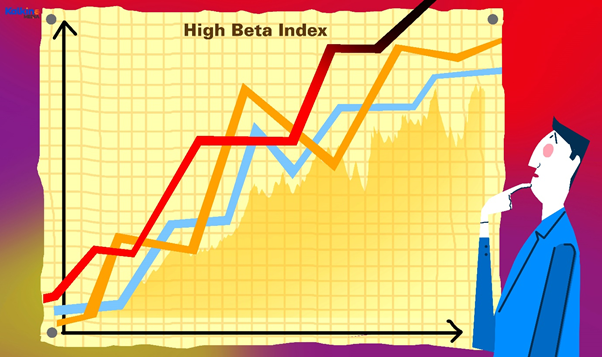High Beta Index
What do you mean by High Beta Index?
A high beta index lists stocks that show more volatility than an expansive market file like the S&P 500 Index. The S&P 500 High Beta Index is the most notable of these lists. It tracks the exhibition of 100 organizations in the S&P 500 that are the most delicate to changes in market returns. Financial backers can get to the S&P 500 High Beta Index through the Invesco S&P 500 High Beta Index ETF. This trade exchanged asset tracks the 100 stocks in the S&P 500 that have shown the most elevated beta readings over the past year. Roughly 33% of the asset's holdings comprise public companies traded on the exchange in the financial services sector.
Beta is the measure of volatility or systematic risk a resource displays contrasted with the market in general. Standard and Poor's offers various high beta varieties for small-cap, mid-cap, and other market indexes other than the large-cap index.

Understanding High Beta Index
Beta is viewed as an estimation of systematic risk, which applies to the wide securities exchange instead of an individual stock. Notwithstanding, beta is, in reality, a more significant amount of a pointer of volatility. For instance, the general securities exchange may encounter a day when considerable market files bit by bit rise and close 2% higher on the day.
During that very day, a high beta stock may ascend in cost 5%, be down 2% on the day, then, at that point, be up 3%, and ultimately close with a similar increase as the general market – 2%. Thus, albeit the stock finished the day with an addition in value equivalent to that of the general market, it did, during the exchanging day, offer financial backers the chance to sell out their situation in the stock for an essentially more noteworthy increase of 5%.

Source: Copyright © 2021 Kalkine Media
A beta perusing of 1 implies that stock generally moves couple with the general securities exchange. Consequently, if a significant market record, for example, the S&P 500, is up or down 3%, then, at that point, the stock is likewise prone to be up or down around 3%. Thus, beta readings somewhere between 0 and 1 show stock will probably encounter somewhat similar movement like the general financial exchange.
Beta readings more noteworthy than 1 demonstrate that a stock will probably encounter more prominent here and there swings in cost than the public securities exchange displays. A stock with a beta perusing of 2 is rough twice as unstable in its value developments as the general securities exchange is. Most of the stock beta lies somewhere between 0 and 3.
It is generally unusual that a stock has a negative beta reading. A negative beta worth shows that a stock's value developments will typically negatively connect with the general securities exchange. The stock will, in available ascent when the broad market falls and to fall when the overall market rises.
Acquiring exposure to a high beta record requires a speculation vehicle, for example, an exchange-traded fund (ETF). The Invesco S&P 500 High Beta ETF (SPHB) is a generally exchanged resource that tracks unpredictable resources in the more extensive market. The ETF has failed to meet the expectations of the primary S&P 500 Index since its inception. Financial organizations establish almost 30% of the asset's resources, with Discover Financial Services (DFS), Lincoln National Corp (LNC), and Invesco (IVZ) among its most significant property.
Investors look to the stocks in a high beta record to accomplish better than showcasing regular profits from the venture. Such financial backers frequently center around high beta stocks when the general securities exchange is exceptionally bullish, hoping to amplify possible additions from the greater volatility of the underlying instrument.
But an investor should keep in mind that with the potential for more significant yields comes a higher risk profile, as the two increases and misfortunes can be intensified contrasted with the general securities exchange. Financial backers will generally avoid high beta stocks during bear markets, as they may endure more significant losses than the general securities exchange.
A few examinations show that low beta stocks beat high beta stocks over the long haul. In any case, it doesn't imply that financial backers probably won't accomplish more significant yields on speculation by exploiting the more volatility showed by high beta stocks.
Frequently Asked Questions
- What are the limitations of a High Beta Index?
As opposed to mainstream thinking, high beta or unpredictability doesn't convert into more noteworthy returns. For a long time, the High Beta S&P 500 Index has failed to meet the expectations of its fundamental benchmark. This happened during a time of resolute improvement in the more extensive market.
Secondly, research shows that low volatility stocks will procure more risk-adjusted returns than high instability stocks. The low explanation beta will, in general, can be ascribed to investor's behavioral biases. Also, sector choice and other vital standards assume a significant part in the instability and execution of a high beta file.
Beta helps decide a security's momentary danger and dissect volatility to show up at value costs when utilizing the CAPM. In any case, since beta is determined using authentic information focuses, it turns out to be less significant for financial backers hoping to anticipate a stock's future developments.
Beta is likewise less valuable for long-haul speculations since a stock's instability can change essentially from one year to another, contingent on the organization's development stage and different variables.
 Please wait processing your request...
Please wait processing your request...